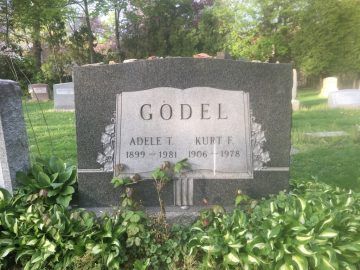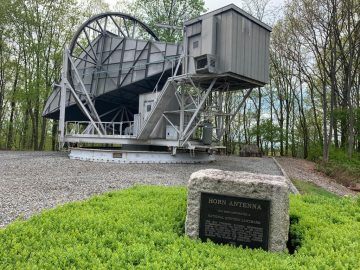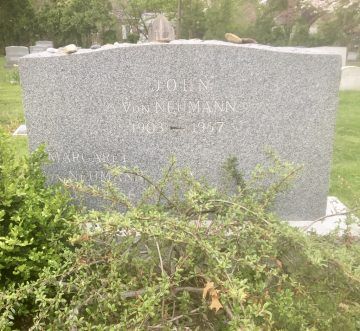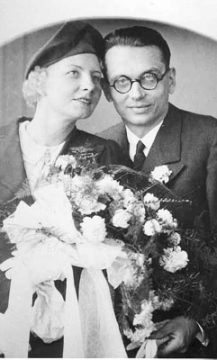On a whim I decided to visit the gently sloping hill where the universe announced itself in 1964, not with a bang but with ambient, annoying noise. It’s the static you saw when you turned on your TV, or at least used to back when analog TVs were a thing. But today there was no noise except for the occasional chirping of birds, the lone car driving off in the distance and a gentle breeze flowing through the trees. A recent trace of rain had brought verdant green colors to the grass. A white-tailed deer darted into the undergrowth in the distance.

The town of Holmdel, New Jersey is about thirty miles east of Princeton. In 1964, the venerable Bell Telephone Laboratories had an installation there, on top of this gently sloping hill called Crawford Hill. It was a horn antenna, about as big as a small house, designed to bounce off signals from a communications satellite called Echo which the lab had built a few years ago. Tending to the care and feeding of this piece of electronics and machinery were Arno Penzias – a working-class refuge from Nazism who had grown up in the Garment District of New York – and Robert Wilson; one was a big picture thinker who enjoyed grand puzzles and the other an electronics whiz who could get into the weeds of circuits, mirrors and cables. The duo had been hired to work on ultra-sensitive microwave receivers for radio astronomy.
In a now famous comedy of errors, instead of simply contributing to incremental advances in radio astronomy, Penzias and Wilson ended up observing ripples from the universe’s birth – the cosmic microwave background radiation – by accident. It was a comedy of errors because others had either theorized that such a signal would exist without having the experimental know-how or, like Penzias and Wilson, were unknowingly building equipment to detect it without knowing the theoretical background. Penzias and Wilson puzzled over the ambient noise they were observing in the antenna that seemed to come from all directions, and it was only after clearing away every possible earthly source of noise including pigeon droppings, and after a conversation with a fellow Bell Labs scientist who in turn had had a chance conversation with a Princeton theoretical physicist named Robert Dicke, that Penzias and Wilson realized that they might have hit on something bigger. Dicke himself had already theorized the existence of such whispers from the past and had started building his own antenna with his student Jim Peebles; after Penzias and Wilson contacted him, he realized he and Peebles had been scooped by a few weeks or months. In 1978 Penzias and Wilson won the Nobel Prize; Dicke was among a string of theorists and experimentalists who got left out. As it turned out, Penzias and Wilson’s Nobel Prize marked the high point of what was one of the greatest, quintessentially American research institutions in history.

I drove up Crawford Hill with a cousin on a bright May Sunday, half-expecting a chain link fence to block us. But the path was wide open and there wasn’t a soul in sight. As we approached the antenna we saw dilapidated shacks and sheds with equipment strewn around. A tractor hung there with its axel visible and rusting. The pigeon droppings were back. The antenna is not completely forgotten because the National Park Service has a plaque there designating it as a National Historic Landmark, but there’s nothing else; no account of the discovery itself expect a recognition that it happened. At the foot of the antenna is more equipment – cables, tanks of liquid nitrogens – with their function and fate uncertain. A few dozen yards from the horn antenna is another Bell Labs installation, this one looking like something straight out of Greek or Roman ruins, a crumbling monument to lost glory. Rusty gas tanks and scaffolding, more cables and wooden structures in various degrees of decay and neglect surround the engineering artifact.
As you walk away you can’t help but feel a profound sense of loss and sadness. Echoes of a distant past impinge on your heavy heart, much like the radiation that Penzias and Wilson discovered here that will continue to quietly fill the ever-expanding void long after we have all disintegrated into our atomic essence. With everything going on, this distant memory from the era of American innovation seems like a timekeeping ghost that will continue to haunt the future. Bell Labs was the most productive research laboratory in the world for almost five decades. A “Member of Technical Staff” title there was probably the most prestigious professional job title anywhere. As Jon Gertner so ably describes in his biography of the laboratory, “The Idea Factory”, not only did the lab invent revolutionary commercial products like the transistor and satellite communications that completely transformed our way of life, but it also produced a dozen Nobel Laureates like Penzias and Wilson who completely transformed our view of the cosmos. As if to drive home the stunning fall of this giant of American science and technology, the sign in front of the modest, gray building bids you farewell – “Nokia Bell Labs”. Fifty years from now, would we see that beautiful little hill as the hill on which American innovation chose to die?
Drive west about fifteen miles and you see another kind of death. It’s the death of two friends who are buried only a few feet from each other. There are hundreds of beautiful gravestones in Princeton Cemetery, and I realized that unless I asked someone, I would end up wandering around for hours looking for what I wanted. The groundskeeper drove me around in his little cart – “This is where the scientists are all buried”, he said. Is there a plot expressly reserved for the scientists, I asked. No, he said, but sometimes they like to be near each other.

The sun was still shining bright on a beautiful day, and I could take my time. Among the several similar-looking gravestones was the one I was looking for. “John von Neumann, 1903-1957”. Right below is the name of Margaret von Neumann, 1881-1956. The dates are instructive. John von Neumann – mathematician, child prodigy who knew calculus and six languages by the time he was ten, computer scientist, economist, physicist, polymath, widely deemed to be the fastest and most wide-ranging mind of the 20th century. His mother Margaret – married to Johnny’s father Max, a rich banker in glittering, turn of the century Budapest. Both refugees from fascism. When Margaret died in 1956 Johnny was heartbroken. His mother had doted on him. This first-generation immigrant who was a patriot, who had created game theory, modern computing and the mathematical underpinnings of quantum theory, who had presidents and generals and senators eagerly seeking his every word; this titan of modern science was just Jancsi for her. When Jancsi heard of his mother’s death, it compounded his own tragedy, for he was then less than a year away from the cancer that would kill him at age fifty-four, while he was still at the height of his powers. Five years later his wife Klara would walk into the Atlantic Ocean, bedecked in fine jewelry. Now I stood in front of his grave, the fastest thinker of his time having consigned his body and soul to the limitlessly slow processes of disorder and geological time.
Just a few feet away from von Neumann’s resting place lies an owlish, elfin man who arrived in the United States in the spring of 1940 after taking a long route through Siberia and the Pacific to avoid the difficulties of crossing a U-boat-riddled Atlantic. “Kurt F.” had finally deemed the situation in Europe too dangerous to continue living in Vienna, that now crumbling cradle of mathematical, philosophical and artistic thought. His friend Johnny who had come to the country seven years before had written several letters petitioning his employer, the Institute for Advanced Study in Princeton, to help Kurt Gödel obtain a visa and flee from the Nazi menace. The institute had become a haven for von Neumann, Einstein and others persecuted in Europe, providing them with the land of liberty that had beckoned the Pilgrims of Massachusetts three hundred years ago. In his letters Johnny said that Gödel was the most accomplished logician of the century and that he would be a wholly unique addition to the institute faculty. Later, when Gödel’s eccentricities – throughout his life he was plagued by deep insecurities and paranoia – and an insufficient appreciation of his work led to delays in his promotion, von Neumann asked, “How can any of us call ourselves ‘Professor’ if Gödel cannot?”. A year before von Neumann died, Gödel wrote him a letter in which, after expressing shock about his cancer and hope that he would be cured, he conjectured what is considered the first description of the famous P=NP problem in computer science, a reference all the more remarkable given that Gödel had never expressed any serious interest in Johnny’s pioneering computing work.
More than ten years before, Gödel had made a mathematical announcement which was every bit as important as Penzias and Wilson’s announcement of the universe’s birth. While the Big Bang theory told us the near certainty of how the universe was born, Gödel’s announcement told us about the fundamental uncertainty of knowledge itself. His famed incompleteness theorems drove a nail into the coffin of a grand project of axiomatizing all of mathematics and showed that every mathematical system without exception had a kernel of either incompleteness or inconsistency at its core. In other words, every mathematical system contained statements that would be both true and false, whose truth value could never be determined. What was even more damning was a parallel finding; that there would also be statements which would be true but which could not be proved to be so in the same mathematical system. As with many seminal scientific advances, Gödel’s announcement at a 1929 Königsberg conference caused hardly any ripples. But there was one person in the audience who understood the profound implications of his work for the fundamental uncertainty of knowledge – John von Neumann. After the talk von Neumann spoke to Gödel, and in a few days his lightning-fast mind had expanded Gödel’s initial idea to what was called the Second Incompleteness Theorem, a conclusion which young Kurt had already derived.
Since then the two had become friends, and von Neumann was instrumental in getting the institute to hire Gödel. However, it wasn’t he who was Gödel’s best friend. That honor belonged to a fading icon who was considered too behind the times by mainstream physicists because of his unhappiness with the meaning of quantum theory. Einstein was more of an institution than an active physicist in the 40s and 50s – the sharp-tongued Robert Oppenheimer who was the institute’s director called him “a lighthouse, not a beacon” – but Princetonians still saw him walking to and back from the institute in his baggy trousers and hat. They also noticed his daily walking companion, an owlish man who seemed to dress in heavy woolen coats even in the balmiest of summers. In his later years, Einstein said that his own work didn’t mean much to him, and that he came to work mainly for the privilege of walking home with Kurt Gödel.

Gödel’s gravestone is a little more ornate than von Neumann’s; perhaps his family wanted it that way or perhaps it spoke to his whimsical love of ordinary, earthy things like children’s fairy tales. It lists the name of his beloved wife Adele, a nightclub dancer who was deemed too ordinary and unsophisticated for Kurt by his family. But Adele nurtured Kurt through his many imagined and real illnesses and once defended him with an umbrella from Nazi hecklers. In Princeton Adele became his caretaker, guiding him through a deeply insecure, literal view of the world which gradually turned into paranoia that there were dark forces at work threatening to poison him. Soon he would only eat food that his dutiful wife had prepared for him. After Adele herself had to spend an extended spell in the hospital because of an illness, Kurt stopped eating altogether. In 1978 he entered Princeton Hospital, weighing not more than eighty pounds, and died essentially of starvation and self-neglect. For the man who had discovered the most rational uncertainty at the heart of the most rational field of human inquiry, his own end was tragically irrational.
Johnny’s end was even more heartbreaking. A man whose only purpose in life seemed to be to think, when he found out he had cancer, he realized that one day his mind would simply cease to think. This he simply could not fathom. Johnny had been instrumental in the United States’ supremacy in both atomic weapons and ballistic missile technology, and because of his importance to national security he was given a special hospital suite at Walter Reed Hospital near Washington D.C., and a coterie of air force officers was posted round the clock, tending to his every need; part of the reason for the armed guard was to ensure he would not give out secrets in his sleep, even as the cancer had relentlessly spread to his brain. He had been recently appointed to the prestigious Atomic Energy Commission and had received the Medal of Freedom from President Eisenhower, but the hand of death tugged at him with relentless certainty. Another high-ranking atomic energy commissioner named Lewis Strauss remembered an unforgettable scene in the hospital – this first-generation immigrant surrounded by the secretaries of the army, navy and air force and the joint chiefs of staff, hanging on to his every word before it disappeared into history’s scorecard.
The end when it came was cruel. To feel reassured that his mind was still working, von Neumann would ask his daughter Marina and his friends Edward Teller and Stanislaw Ulam to ask him simple arithmetic questions, such as the sum of four and seven. They would come out of his suite shaken and heartbroken. Just like his friend Kurt, Johnny’s ultra-rational mind succumbed to the irrationality of believing that he would be saved by religion, and he asked a Catholic priest to convert him to religion and carried out learned discourses with him in Latin and Greek, the kind of discourses which he had awed his father’s friends with as a child prodigy in Budapest. When he asked his brother to read to him from Goethe’s Faust, his photographic memory would start reciting the next few sentences. John von Neumann died in February 1957; on his hospital bed lay a set of notes comparing the brain with the computer and proposing new directions for neuroscience and computing. At his burial in Princeton Cemetery were both Robert Oppenheimer and Lewis Strauss, sworn enemies of each other; somehow Johnny always managed to be friends with people who were each other’s enemies.
But none of that mattered in Princeton Cemetery. As I stood there, I could not help but notice something striking – that Gödel and von Neumann’s graves were basically indistinguishable from those of hundreds around them; two of the most important minds in scientific history lying in the middle of other merely very good ones. Men and institutions have an expiry date, just like civilizations. It’s the one certainty that even Gödel cannot overturn. Ultimately the universe exerts a great leveling effect and we are all the same, beginning and ending in the same way. But our ideas are what make the difference. Gödel discovered a paradox at the heart of seemingly certain mathematical knowledge: he found that permanence is transient. And yet his and von Neumann and Bell Labs’ lives, vanishingly brief compared to the intervals between stars, showed us the opposite: that transience can lead to permanence through ideas. Ultimately we may begin and end in the same way, but whether it’s Gödel or von Neumann or a little antenna on the top of a hill, it’s our middles that distinguish us. And over those middles we seem to be able to exercise an inordinate degree of control.
 The British Are Coming: The War for America, Lexington to Princeton, 1775-1777 by Rick Atkinson
The British Are Coming: The War for America, Lexington to Princeton, 1775-1777 by Rick Atkinson


